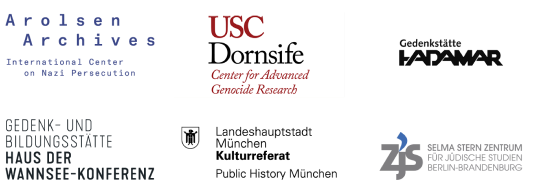Annotations
Wiesbaden
August/September 1942
This picture in portrait format shows a helper loading the luggage of the deportees. Police officers in uniform and plain clothes stand around him.
Annotations
Keywords
6
Historical context
Deportation von Wiesbaden nach Theresienstadt am 1. September 1942
On September 1, 1942, the third major deportation of people persecuted as Jews took place in Wiesbaden. On the instructions of the Frankfurt Gestapo, people aged over 65 were to be targeted for deportation. On August 29, 1942, around 350 people were called upon to present themselves, by 1 p.m. at the latest, at the synagogue in Friedrichstraße which the Gestapo was using as an assembly camp. Forty people committed suicide in the week after they were notified of their impending deportation. In the assembly camp, the deportees had to wear a cardboard sign measuring 18 by seven centimeters with their name and identification number. After three days in cramped conditions, at four o’clock in the morning of September 1, 1942, the people had to walk to the cattle loading ramp at Wiesbaden main train station that had originally been built for the neighboring slaughterhouse. There they had to board a train that would be connected to the "Da 503" deportation train to Theresienstadt in Frankfurt am Main. Soon after arriving in Theresienstadt, 268 of the 1,100 deportees were transported on to Treblinka and murdered there.
About the image series
It is not known how many pictures were taken of the deportation from Wiesbaden. Researchers are currently aware of 38 photos that have survived as negatives, but cannot be found. They show mostly elderly people waiting for "registration" in the courtyard of the synagogue at Friedrichstraße 33 that the Gestapo was using as an assembly camp, the overcrowded prayer room, and the departure of more than 350 people from the cattle loading ramp at Wiesbaden's main train station that belonged to the slaughterhouse. The pictures were taken on August 29 and September 1, 1942, possibly also on the days in between. Apart from the deportees, you can see numerous not yet identified perpetrators as well as Jewish helpers caring for the people in the assembly camp.
Photographer
Unknown, Unknown
Provenance
The Wiesbaden deportation series became known to the public in the 1980s when some of the pictures from the collection of photographer and photo lab assistant Richard Rudolph were used for an exhibition in the town hall. After the exhibition, sets of pictures containing different numbers of photos and different selections of motifs kept finding their way into various archives abroad as a result of survivors having purchased the pictures in Richard Rudolph’s store. In 1998, the whole series was used for the first time for the design of a mobile commemorative container. The entire "Foto Rudolph" collection has been in the Hessische Hauptstaatsarchiv (Hessian Main State Archive) since 2011. However, the negative films have been lost, and a complete collection of high-resolution digital copies or prints no longer exists.
Call number at source archive
3008/2 Nr. 16586
Title at source archive
Deportation von jüdischen Wiesbadenern an der Verladerampe des Schlachthofs, Bild 26
Acknowledgements
Many thanks to Kay Dreyfus, who meticulously researched the photos and significantly contributed to our understanding of the Wiesbaden picture series. We would also like to thank Dr. Lukat from the Stadtarchiv (municipal archive) in Wiesbaden and Dr. Lehnhardt from the Hessische Hauptstaatsarchiv for providing useful documents and information.
Text and research by Lisa Paduch.
Kooperationsverbund #LastSeen. Bilder der NS-Deportationen Dr. Alina Bothe Projektleiterin
c/o Selma Stern Zentrum für Jüdische Studien Berlin-Brandenburg
Freie Universität Berlin
Habelschwerdter Allee 34A
14195 Berlin
lastseen@zedat.fu-berlin.de
Ein Kooperationsprojekt von

Gefördert durch

Datenschutz | Impressum